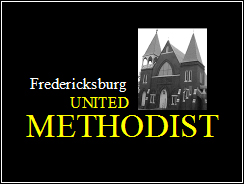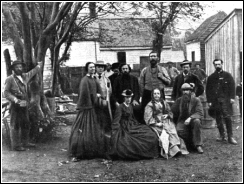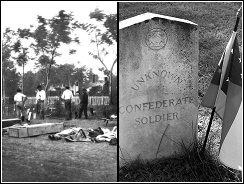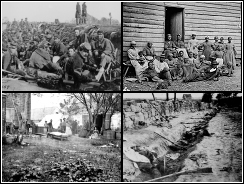|

|

|
FREDERICKSBURG
METHODIST
Perhaps no other church in
this study was as disrupted by the debate
over the institution of slavery as was the
Methodists. In fact, differing views over
the slave trade would pit members against
one another resulting in a full-blown
split of the congregation. This
denomination was established at a revival
event recorded as the "Christmas
conference of 1784," at the Lovely Lane
Chapel in Baltimore, Maryland.
|
|
The result was the
official christening of the Methodist
Church of America. Almost immediately upon
its formation, the ordained
superintendents of Methodism began an
intensive campaign to spread their new
theology across the landscape. Immediately
a controversy erupted as the anti-slavery
views of some of the church's first
preachers did not sit well with many of
the South's citizens.
In fact, just a few
decades into its existence, the issue of
slavery would once again rear its ugly
head and ignite a feud within the
congregation itself. The results would be
drastic to say the least. Arguments over
slavery in the Old Dominion had been a
long-standing debate almost one-hundred
years before the Methodists split over it.
According to an article printed in an 1887 issue of American History
Magazine:
In 1790, Virginia claimed
293,427 registered slaves, which was more
than seven times the number in the
northern states combined." Ironically it
also states that, the Reverend Morgan
Godwin of the early English Church is said
to be one of the first clergymen "who ever
lifted up his voice against the African
slave trade.
Prior to the Civil War,
the building housing the Methodist Church
stood as a charming two-story brick
structure located on the south-side of
Hanover Street between Prince Edward and
Princess Anne Streets. Attending members
were estimated to be at approximately 115
white members and 53 black members. In
1848, a large portion of the membership
began an exodus of their own due to the
acrimonious debate over slavery and in
1852; they constructed their own meeting
house (Methodist Church South) one block
from the parent church.
In 1861 the original
church rolls listed 164 members, while the
new branch boasted 290 followers. Both
sites would see significant action during
the War Between the States and provide a
gruesome service for the occupying Federal
forces. I've mentioned throughout my talk
tonight about the use of these churches as
field hospitals, but I'd like to address
that in more detail as FUMC had some
striking recollections of these
events.
SPACER
|
|

|
U.S. SANITARY
COMMISSION
Here is a photo of some of
the U.S. Sanitary Commission who came to
Fredericksburg to help administer aid and
prevent the spread of disease. In essence,
they were like the Red Cross Disaster
Relief. Even some local civilians rallied
together to provide charity and compassion
to those in need, even if they were 'the
enemy.'
|
|
A young soldier stationed
in the 57th recalled an angel of mercy of
his own that he met while lying in the
Methodist Church. He wrote:
For the first few days at
Fredericksburg it was almost impossible to
obtain bandages. The women, with a few
exceptions, were bitter rebels and would
do all they could to prevent us from
finding or buying a single piece of cloth.
The bandage with which my own wound was
bound up was part of the white skirt
belonging to an elderly lady who brought
roses into the Southern Methodist Church
where I was lying, a Mrs. McCabe. Seeing
the need of a bandage, she loosed her
skirt, cut it into strips, and handed it
to my father, who proceeded to dress my
own and other soldier's wounds.
Casualties were separated
using a triage procedure with all the
wounded that could travel being loaded
into mile-long caravans of army wagons
(some designated as ambulances and some
not). Those who were too seriously injured
to move, or near death would be left
behind in field hospitals that were
usually established in whatever large
buildings were available. Members of the
Medical Corp., as well as the Christian
and/or Sanitary Commission, and local
residents would then be charged with
caring for those left behind. In the case
of a retreat, the fallen would inevitably
be left to the care and compassion of the
enemy.
Due to its relative
close-proximity to the U.S. capitol,
Federal wounded were continuously being
evacuated back across the Rappahannock
River and north toward the army hospitals
in Washington DC. Many men were lined up
in rows outdoors and prepped for
transportation via water routes. The
city's churches, farms, and even estates
such as Chatham Manor were filled to an
overflowing capacity with the dead and
dying.
SPACER
|
|

|
DEALING WITH THE
DEAD
J.E.B. Stuart wrote of the
suffering: The victory
won by us here is one of the neatest and
cheapest of the war. Englishmen who
surveyed Solferino & all the
battlefields of Italy say that the pile of
dead on the plains of Fredericksburg
exceeds anything of the sort ever seen by
then…Fredericksburg is in ruins. It is the
saddest sight I ever saw.
|
|
Like all of their
neighboring congregations, Fredericksburg
Methodist and its sister parishioners at
Fredericksburg Methodist South emerged
from the War Between the States battered,
scarred, and traumatized. As the rest of
the nation was in the process of reuniting
and seeking both forgiveness and
reconciliation, so too was the Methodist
faith, which had been torn in half over
the institution of slavery much like the
rest of the country.
Following the South's
surrender, the Baltimore Conference voted
to become part of the Methodist Episcopal
Church South, thus opening the door for a
unification of the two split
congregations. Eventually the George
Street branch was absorbed into the
Hanover Street Church and the Methodist
family of Fredericksburg was finally
together again.
SPACER
|
|

|
POINTS OF VIEW
Understandably, the
tragedies and triumphs of the Civil War
stuck in the hearts and minds of the
South's inhabitants. In some cases it even
widened a gap between many of the
surviving citizens. Fredericksburg was no
exception to this dilemma. It would take
years for the town to recover both
physically as well as mentally.
|
|
To the white residents who
had supported or served in the Confederate
cause, the South's loss left them with a
bitter feeling of defeat. To the Unionist
citizens who had voiced their loyalty in a
risky and unpopular arena, the North's
victory gave them a sense of validation.
Certainly no one appreciated the struggle
for independence more than the now-freed
black citizens. Unfortunately their
struggles were far from over.
As time passed, wounds
were healed, yet there were battles that
were still yet to come. Nearly a century
later America still struggled over
equality and was divided again. The
efforts to end segregation in the South
formed a new civil rights movement that
reinvigorated the public in the fight to
establish equal rights for blacks. Once
again, Fredericksburg weathered the storm
and emerged a stronger community.
Today, our city is a
popular tourist attraction. And we are so
very fortunate to live in a town that
others travel across oceans to visit.
Fredericksburg is also now a unique place
memorializing Confederate, Union, and
African-American pride.
Many people come here to
visit a town whose legacy has been cast in
the story of a nation divided. However,
after completing my research into the
churches of Fredericksburg, I am
thoroughly convinced that the real story
is more accurately that of a town
reunited.
Thank you.
|
|